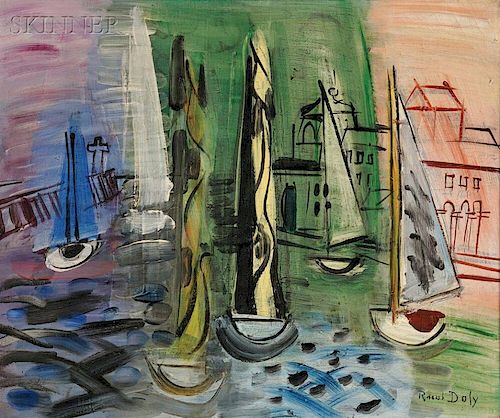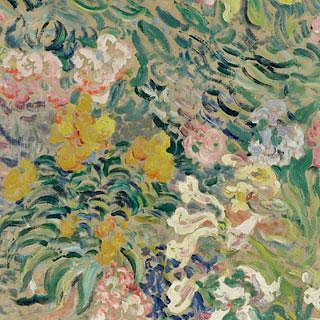Raoul Dufy (French, 1877-1953) Régates à Trouville
Lot 379
About Seller
Bonhams Skinner
274 Cedar Hill Street
Marlborough, MA 01752
United States
Founded over four decades ago, Bonhams Skinner offers more than 60 auctions annually. Bonhams Skinner auctions reach an international audience and showcase the unique, rare, and beautiful in dozens of categories, including the fine and decorative arts, jewelry, modern design, musical instruments, sc...Read more
Categories
Estimate:
$120,000 - $180,000
Absentee vs Live bid
Two ways to bid:
- Leave a max absentee bid and the platform will bid on your behalf up to your maximum bid during the live auction.
- Bid live during the auction and your bids will be submitted real-time to the auctioneer.
Bid Increments
| Price | Bid Increment |
|---|---|
| $0 | $10 |
| $100 | $25 |
| $500 | $50 |
| $1,000 | $100 |
| $3,000 | $250 |
| $5,000 | $500 |
| $10,000 | $1,000 |
| $30,000 | $2,500 |
| $50,000 | $5,000 |
| $100,000 | $10,000 |
| $300,000 | $25,000 |
| $500,000 | $50,000 |
| $1,000,000 | $100,000 |
About Auction
By Bonhams Skinner
May 13, 2016 - May 14, 2016
Set Reminder
2016-05-13 16:00:00
2016-05-14 16:00:00
America/New_York
Bidsquare
Bidsquare : Fine Paintings & Sculpture
https://www.bidsquare.com/auctions/skinner/fine-paintings-sculpture-1460
Bonhams Skinner bidsquare@bonhamsskinner.com
Bonhams Skinner bidsquare@bonhamsskinner.com
- Lot Description
Raoul Dufy (French, 1877-1953)
Régates à Trouville
Signed "Raoul Dufy" l.r., identified on a label from Colman Art Gallery, Philadelphia, affixed to the reverse.
Oil on canvas, 15 x 18 1/4 in. (38.1 x 46.4 cm), framed.
Condition: Cracquelure to heavy impasto areas in the center of the painting, fine craquelure over entire surface, surface grime.
Provenance: Purchased in Paris in the early 1950s, to a private Virginia collection.
N.B. Legend has it that upon painter Raoul Dufy's death, Henri Matisse proclaimed: "Dufy's work will live!" Dufy had mutual esteem for his fellow Fauvist painter and was greatly influenced by his work at the infamous 1905 exhibition at the Salon d'Automne. There, Dufy had a revelation and said: "How can I use these means [the pigments and brushes] to express not what I see, but what is, what exists for me, my reality? . To study sunlight is a waste of time. Light in painting is something quite apart: it is composed, it is arranged, and it is colored." From that moment, Dufy used bold, bright colors and vivid brushstrokes to depict lighthearted garden parties, breezy regattas, and velocious horse races.
Born Raoul-Ernest-Joseph Dufy on June 3, 1877 in Le Havre, a busy seaport on the north bank of the Seine estuary, the young artist showed talent at an early age. In 1900, the town of Le Havre awarded him a grant to study art in Paris where he learned, and then had to unlearn, the lessons from the Academy des Beaux Arts. Although based in Paris, Dufy traveled extensively throughout France, often finding himself drifting towards the coast to capture scenic sea views. Like the Impressionists, Dufy frequently painted a large number of pictures of the same motif, varying ever so slightly certain compositional details and color hues. Unlike that earlier generation of artists, Dufy's audacious colors radically departed from natural hues, exuding the confidence of his Fauvist counterparts.
This cheerful painting of the regattas at Trouville was most probably completed in 1935 when Dufy was at the peak of his career. Boats bob lightly through the choppy waters as they enter the harbor. Dufy simplified the schooners, and overlooking buildings, to their essential forms using thick black outlines and gestural brushstrokes. Seemingly superimposed over this view of Trouville, are large, bright sections of blue, green, and red. These areas of pigment are dissociated from the descriptive task of rendering the arresting view, and yet the colors dramatize the regatta. Coincidentally, Claude Monet painted the same harbor some 56 years before Dufy. This would not have been lost on the Fauvist, who at the time had, at last, attained considerable fame. While Monet diligently depicted the reflections of sails and hulls on the shimmering water, Dufy abstracted from nature to render the same view with chromatic brilliance and dynamic force.
A certificate of authenticity issued by Raoul Dufy scholar Fanny Guillon-Laffaille will accompany the lot.
Estimate $120,000-180,000
Crackle most evident in the black mast and yellow sail of the central boat. Also visible in the blue mast of the boat on the left. Surface grime particularly visible in the upper right quadrant.
The absence of a condition statement does not imply that the lot is in perfect condition or completely free from wear and tear, imperfections or the effects of aging. Condition requests can be obtained via email (lot inquiry button) or by telephone to the appropriate gallery location (Boston/617.350.5400 or Marlborough/508.970.3000). Any condition statement given, as a courtesy to a client, is only an opinion and should not be treated as a statement of fact. Skinner Inc. shall have no responsibility for any error or omission. - Shipping Info
-
Please visit http://www.skinnerinc.com/services/payment-and-shipping/ for information regarding the collection of items purchased at auction.
-
- Buyer's Premium



 EUR
EUR CAD
CAD AUD
AUD GBP
GBP MXN
MXN HKD
HKD CNY
CNY MYR
MYR SEK
SEK SGD
SGD CHF
CHF THB
THB











